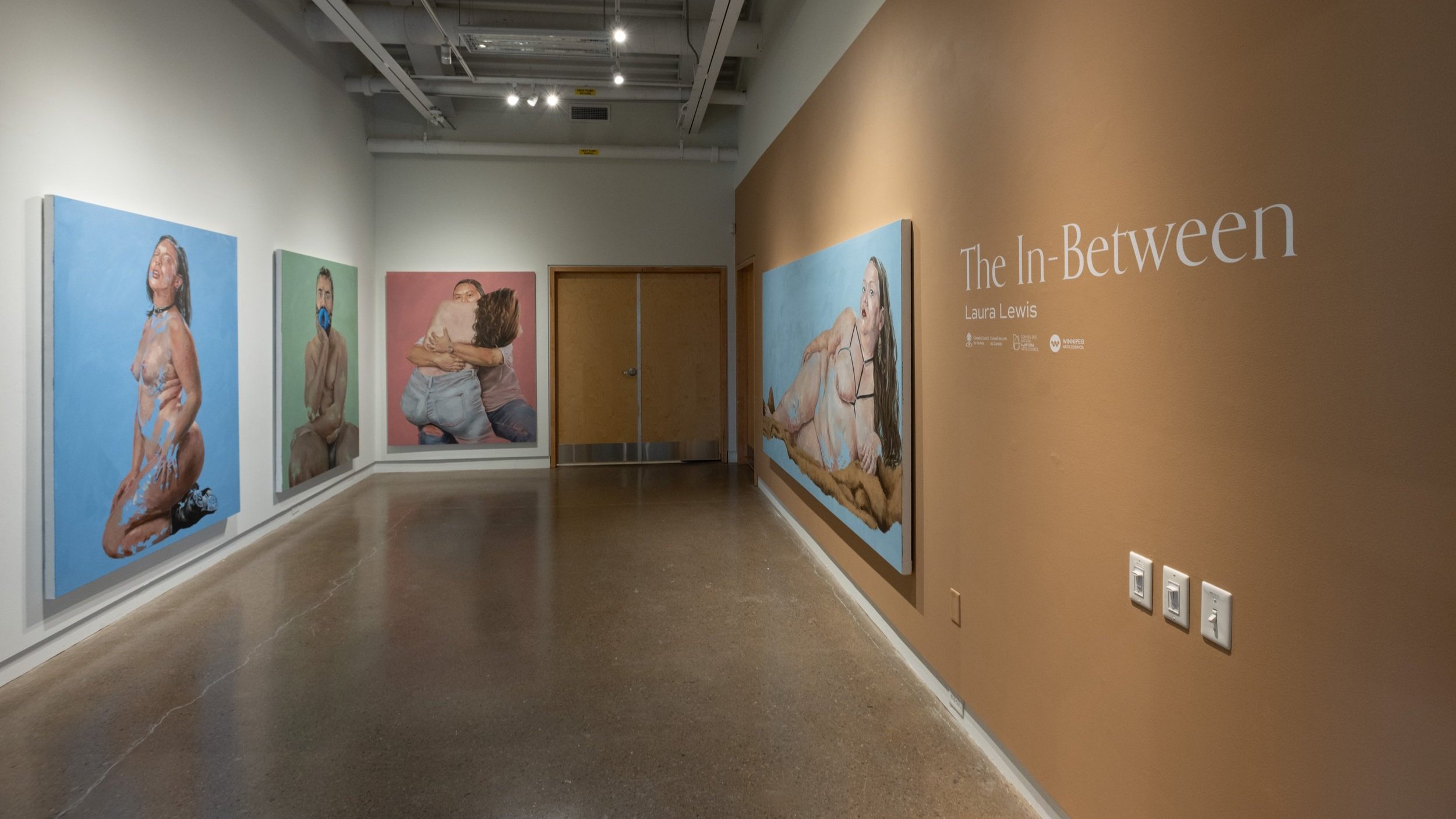The In-Between at Modern Fuel, Kingston Ontario, Canada
May 18 – July 20, 2024
Photos by Chris Miner, 2024
Risqué business: libidinal realism in the work of Laura Lewis
Exhibition review by Madeline Bogoch
In a recent interview with Border Crossings, painter Laura Lewis gently distances herself from the term portraiture, qualifying that while she wouldn’t be offended by the label, she prefers to describe her work as figurative painting. I understand why Lewis, an artist primarily concerned with the mutability of sexuality and identity, would resist the term. If portraiture assumes to preserve one’s identity, then figurative painting offers a more flexible approach, liberating the artist to explore a more expansive and indeterminate definition of the self. This paradigm resonates with Lewis’s large-scale paintings, which engage with portraiture as a historical form while conscientiously reauthoring the dynamics between the artist and subject. The works in The In-Between are at once faithful representations of the subjects— in both their likeness and desires—while also operating as abstractions of individual identity.
Suspended in boldly coloured backdrops that subtly creep into the subjects’ flesh, Lewis’s figures appear outside of real-world contexts (and often clothing). The models in Lewis’s work are friends and fellow artists who, like Lewis, identify as queer. In Arjun with Butt Monster, Jessie in Blue, and Madeline in Oil (which I’ve only now realized is a well-played painterly pun), the subjects don fetish gear, signalling the overlap between the codes of queerness and kink. Lewis’s mindfulness in collaboration is yet another nod to the framework of engaged consent underscored in the kink community, and adapted within her practice to mitigate the risks associated with realism.
Sexuality is never far from the field in Lewis’s paintings, albeit without an overt presence of carnality. Perhaps, this is because the figures appear detached from the messy real-world stakes of sex and instead attuned to the range of desires that might arise once removed from these contexts. There’s a fluidity that is accentuated by the subtle dissolution of the figures into the background, a quality that extends to the core of the show, where the mobility of queerness and identity is emphasized.
Once at a party, someone who would later become a good friend of mine asked me if I’d like to be drawn. I declined, explaining that I preferred to remain oblivious to how I might appear to others. Reflecting on the exchange, I consider the intimacy of allowing oneself to be portrayed, and how Lewis’s investment in these dynamics is evident in her work. The figures appear self-possessed and at ease, qualities which are often undermined by the presence of a camera or paintbrush. The gaze has long been a powerful tool in establishing the tone of a painting and is used here to carve out the poles of intimacy. While several of the works utilize the gaze to invite the viewer in, the enigmatically titled Embrace works in a very different register. In the painting, a couple is depicted, with one figure’s face partially obscured by their lover, locking eyes with the viewer, and implying we are uninvited observers to this intimate moment. I briefly contemplate questioning Lewis about this notable departure from the less guarded mood in her other works, but quickly decide against it. I’m left with the impression that she’s more invested in embracing the irreducible mystery contained in her subjects than revealing them.
Embrace, 2022
Oil on canvas
72 x 60 inches
Madeline in Oil, 2022
Oil on canvas
72 x 60 inches
Arjun with Butt Monster, 2023
Oil on canvas
72 x 60 inches
Jessie In Blue, 2022
Oil on canvas
60 x 120 inches





